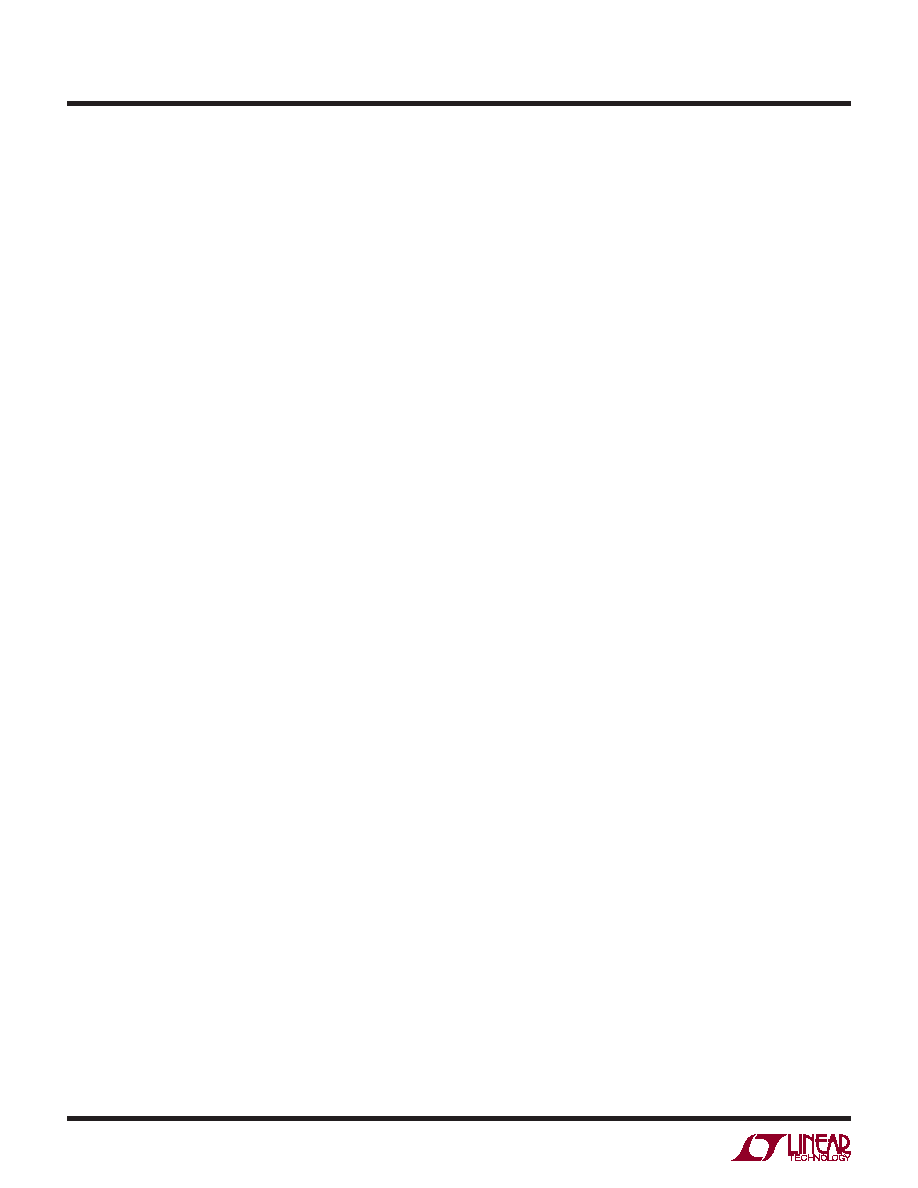- 您現(xiàn)在的位置:買賣IC網(wǎng) > PDF目錄44987 > LT3845AMPFE#TRPBF (LINEAR TECHNOLOGY CORP) SWITCHING CONTROLLER, 500 kHz SWITCHING FREQ-MAX, PDSO16 PDF資料下載
參數(shù)資料
| 型號: | LT3845AMPFE#TRPBF |
| 廠商: | LINEAR TECHNOLOGY CORP |
| 元件分類: | 穩(wěn)壓器 |
| 英文描述: | SWITCHING CONTROLLER, 500 kHz SWITCHING FREQ-MAX, PDSO16 |
| 封裝: | 4.40 MM, LEAD FREE, PLASTIC, TSSOP-16 |
| 文件頁數(shù): | 2/26頁 |
| 文件大?。?/td> | 284K |
| 代理商: | LT3845AMPFE#TRPBF |
第1頁當(dāng)前第2頁第3頁第4頁第5頁第6頁第7頁第8頁第9頁第10頁第11頁第12頁第13頁第14頁第15頁第16頁第17頁第18頁第19頁第20頁第21頁第22頁第23頁第24頁第25頁第26頁

LT3845A
10
3845afa
APPLICATIONS INFORMATION
Overview
The LT3845A is a high input voltage range step-down
synchronous DC/DC converter controller IC that uses
a programmable constant frequency, current mode
architecture with external N-channel MOSFET switches.
The LT3845A has provisions for high efficiency, low load
operation for battery-powered applications. Burst Mode
operationreducestotalaverageinputquiescentcurrentsto
120A during no load conditions. A low current shutdown
mode can also be activated, reducing quiescent current to
10A. Burst Mode operation can be disabled if desired.
A reverse-current inhibit feature allows increased
efficiencies during light loads through nonsynchronous
operation. This feature disables the synchronous switch if
inductor current approaches zero. If full time synchronous
operation is desired, this feature can be disabled.
Much of the IC’s internal circuitry is biased from an
internal linear regulator. The output of this regulator is
the VCC pin, allowing bypassing of the internal regulator.
The associated internal circuitry can be powered from
the output of the converter, increasing overall converter
efficiency. Using externally derived power also eliminates
the IC’s power dissipation associated with the internal VIN
to VCC regulator.
Theory of Operation (See Block Diagram)
The LT3845A senses converter output voltage via the VFB
pin. The difference between the voltage on this pin and
an internal 1.231V reference is amplified to generate an
error voltage on the VC pin which is used as a threshold
for the current sense comparator.
During normal operation, the LT3845A internal oscillator
runs at the programmed frequency. At the beginning of
each oscillator cycle, the switch drive is enabled. The
switch drive stays enabled until the sensed switch current
exceeds the VC derived threshold for the current sense
comparator and, in turn, disables the switch driver. If
the current comparator threshold is not obtained for the
entire oscillator cycle, the switch driver is disabled at the
end of the cycle for 350ns, typical. This minimum off-time
mode of operation assures regeneration of the BOOST
bootstrapped supply.
Power Requirements
The LT3845A is biased using an internal linear regulator to
generate operational voltages from the VINpin.Virtuallyall
of the circuitry in the LT3845A is biased via this internal
linear regulator output (VCC). This pin is decoupled with
a low ESR, 1F capacitor to PGND.
The VCC regulator generates an 8V output provided there
is ample voltage on the VIN pin. The VCC regulator has
approximately 1V of dropout, and will follow the VIN pin
with voltages below the dropout threshold.
The LT3845A has a start-up requirement of VIN>7.5V.This
assures that the onboard regulator has ample headroom
to bring the VCC pin above its UVLO threshold. The VCC
regulator can only source current, so forcing the VCC pin
above its 8V regulated voltage allows use of externally
derived power for the IC, minimizing power dissipation
in the IC. Using the onboard regulator for start-up, then
derivingpowerforVCCfromtheconverteroutputmaximizes
conversion efficiencies and is common practice. If VCC
is maintained above 6.5V using an external source, the
LT3845A can continue to operate with VIN as low as 4V.
The LT3845A operates with 3mA quiescent current from
the VCC supply. This current is a fraction of the actual VCC
quiescent currents during normal operation. Additional
current is produced from the MOSFET switching currents
for both the boosted and synchronous switches and are
typically derived from the VCC supply.
相關(guān)PDF資料 |
PDF描述 |
|---|---|
| LT3845AIFE#TRPBF | SWITCHING CONTROLLER, 500 kHz SWITCHING FREQ-MAX, PDSO16 |
| LT3845AMPFE#PBF | SWITCHING CONTROLLER, 500 kHz SWITCHING FREQ-MAX, PDSO16 |
| LT3845EFE#TR | SWITCHING CONTROLLER, 600 kHz SWITCHING FREQ-MAX, PDSO16 |
| LT3956IUHE#TRPBF | SWITCHING REGULATOR, PQCC36 |
| LT3957EUHE#TRPBF | SWITCHING REGULATOR, PQCC36 |
相關(guān)代理商/技術(shù)參數(shù) |
參數(shù)描述 |
|---|---|
| LT3845EFE | 制造商:LINER 制造商全稱:Linear Technology 功能描述:High Voltage Synchronous Current Mode Step-Down Controller with Adjustable Operating Frequency |
| LT3845EFE#PBF | 功能描述:IC REG CTRLR BUCK PWM CM 16TSSOP RoHS:是 類別:集成電路 (IC) >> PMIC - 穩(wěn)壓器 - DC DC 切換控制器 系列:- 特色產(chǎn)品:LM3753/54 Scalable 2-Phase Synchronous Buck Controllers 標(biāo)準(zhǔn)包裝:1 系列:PowerWise® PWM 型:電壓模式 輸出數(shù):1 頻率 - 最大:1MHz 占空比:81% 電源電壓:4.5 V ~ 18 V 降壓:是 升壓:無 回掃:無 反相:無 倍增器:無 除法器:無 Cuk:無 隔離:無 工作溫度:-5°C ~ 125°C 封裝/外殼:32-WFQFN 裸露焊盤 包裝:Digi-Reel® 產(chǎn)品目錄頁面:1303 (CN2011-ZH PDF) 其它名稱:LM3754SQDKR |
| LT3845EFE#TRPBF | 功能描述:IC REG CTRLR BUCK PWM CM 16TSSOP RoHS:是 類別:集成電路 (IC) >> PMIC - 穩(wěn)壓器 - DC DC 切換控制器 系列:- 標(biāo)準(zhǔn)包裝:2,500 系列:- PWM 型:電流模式 輸出數(shù):1 頻率 - 最大:500kHz 占空比:96% 電源電壓:4 V ~ 36 V 降壓:無 升壓:是 回掃:無 反相:無 倍增器:無 除法器:無 Cuk:無 隔離:無 工作溫度:-40°C ~ 125°C 封裝/外殼:24-WQFN 裸露焊盤 包裝:帶卷 (TR) |
| LT3845EFEPBF | 制造商:Linear Technology 功能描述:60V Current-Mode Controller Adj. TSSOP16 |
| LT3845EFE-PBF | 制造商:LINER 制造商全稱:Linear Technology 功能描述:High Voltage Synchronous Current Mode Step-Down Controller with Adjustable Operating Frequency |
發(fā)布緊急采購,3分鐘左右您將得到回復(fù)。